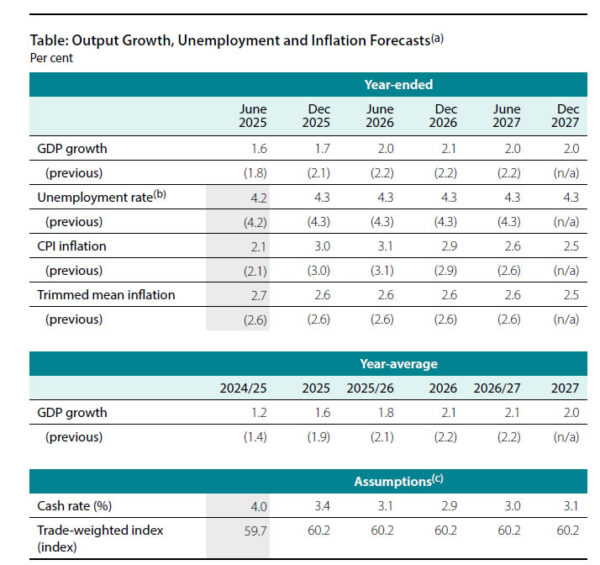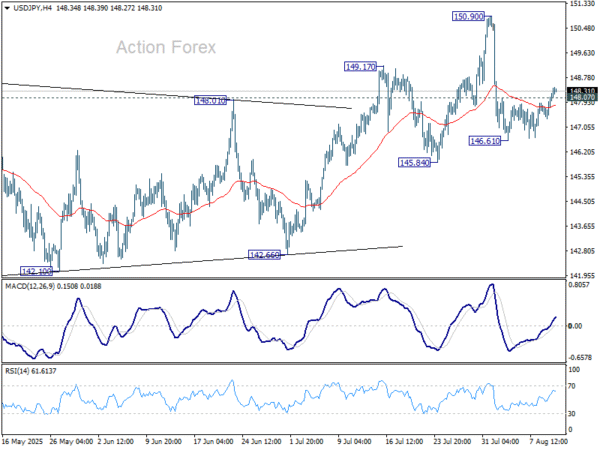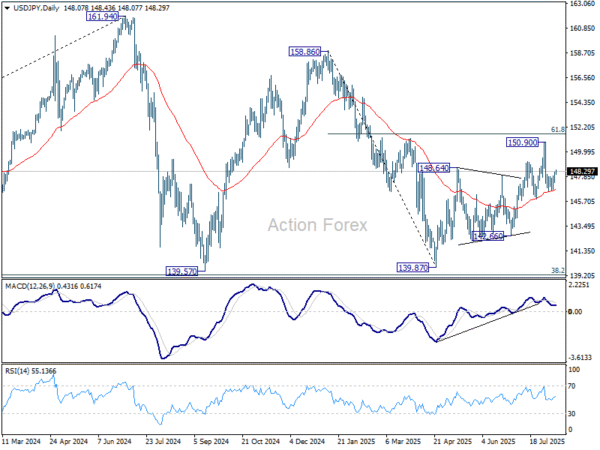Yen Slides as Nikkei Hits Record, US–China Extend Truce – Action Forex
Yen slumped further across the board in Asia as Japanese stocks surged, with the Nikkei charging to all-time highs after the holiday break. Optimism in Tokyo is being driven by expectations that more listed companies will upgrade earnings outlooks, with the perceived impact of US tariffs on Japanese exporters now seen as limited.
Investor sentiment was further buoyed by confirmation that the US and China have agreed to extend their tariff truce by another 90 days. The pause in escalation has removed a key overhang for risk markets for the near term.
As Nikkei advances, momentum in equities is likely to sustain selling pressure on Yen, especially against higher-yielding peers.
In the broader FX market, Aussie is a touch softer alongside Kiwi. RBA’s widely expected rate cut has had only a muted impact on sentiment. The key takeaway from the decision is that with growth forecasts downgraded and inflation steady, policymakers see scope for one more cut this year and two more in 2026.
On the other hand, Swiss Franc is stronger today, recovering some of last week’s losses, while Euro and Sterling are also trading firm. Loonie and greenback are sitting mid-pack in the performance table.
On the trade front, Monday’s US–China announcement forestalled the imposition of triple-digit tariffs on each other’s goods. US President Donald Trump signed an executive order delaying higher tariffs until November 10, maintaining the current 30% duty on Chinese imports, while Beijing confirmed its own 90-day suspension of planned tariff hikes and investment restrictions on US firms.
The extension buys valuable time ahead of the seasonal autumn surge in imports for the Christmas season, keeping electronics, apparel, and toys at lower tariff rates. Without the truce, U.S. tariffs were set to soar to 145% and Chinese duties to 125% — levels that would have amounted to a virtual trade embargo between the world’s two largest economies.
In Asia, at the time of writing, Nikkei is up 2.75%. Hong Kong HSI is up 0.09%. China Shanghai SSE is up 0.51%. Singapore Strait Times is down -0.36%. Japan 10-year JGB yield is up 0.006 at 1.500. Overnight, DOW fell -0.45%. S&P 500 fell -0.25%. NASDAQ fell -0.30%. 10-year yield fell -0.012 to 4.273.
RBA cuts to 3.60%, rate track points to one more this year
RBA lowered the cash rate by 25bps to 3.60% as widely expected, with the decision passed on a unanimous vote. The new forecasts signaled room for one more cut this year, two in 2026, and a hike in 2027.
Updated economic projections showed inflation forecasts unchanged, with year-end CPI at 3.0% in 2025, 3.1% in 2026, and 2.5% in 2027. Trimmed mean inflation was also left steady at 2.6% for 2025 and 2026, easing to 2.5% in 2027.
The growth outlook, however, was revised notably lower. Year-average GDP growth for 2025 was cut from 1.9% to 1.6%, and for 2026 from 2.2% to 2.1%, with 2027 projected at 2.0%.
The forecasts are based on interest rate assumptions of 3.4% in 2025, 2.9% in 2026, and 3.1% in 2027 — implying scope for one more cut this year, two in 2026, followed a hike in 2027.
In its statement, RBA noted that uncertainty in the global economy remains elevated. While recent developments have brought “a little more clarity” on the scope of US tariffs and the policy responses from other countries, the Bank expects that “more extreme outcomes are likely to be avoided.”
Even so, trade policy uncertainty is still expected to weigh on global activity and inflation, with the risk that households and firms delay spending until there is greater clarity. The RBA said these effects will likely continue to drag on the Australian economy “for a period”.
NAB survey shows rising Australian business confidence, pockets of inflation pressure
Australia’s NAB Business Confidence index rose from 5 to 7 in July, and moving just above the long-run average of 5. NAB noted that confidence has been trending higher despite elevated global uncertainty.
Business Conditions slipped from 7 to 5, with weakness seen across all subcomponents. Trading conditions fell from 14 to 11, profitability from 4 to 2, and employment from 4 to 1. While the pullback follows strong gains in June, NAB noted conditions have retained much of last month’s improvement.
Price indicators highlighted ongoing inflationary pressures in pockets of the economy. Labor cost growth accelerated from 1.3% to 2.1% in quarterly equivalent terms. Purchase costs edged up from 1.3% to 1.5%. Final product price growth strengthened from 0.5% to 0.9%, and retail price growth climbed from 0.5% to 1.1%.
USD/JPY Daily Outlook
Daily Pivots: (S1) 147.58; (P) 147.91; (R1) 148.48; More…
USD/JPY’s extended rebound and break of 148.07 resistance suggests that pullback from 150.90 has completed at 146.61 already. Intraday bias is back on the upside for retesting 150.90 first. Firm break there will resume the whole rally from 139.87 to 151.22 fibonacci level. For now, risk will stay on the upside as long as 146.61 support holds, in case of retreat.
In the bigger picture, price actions from 161.94 (2024 high) are seen as a corrective pattern to rise from 102.58 (2021 low). Decisive break of 61.8% retracement of 158.86 to 139.87 at 151.22 will argue that it has already completed with three waves at 139.87. Larger up trend might then be ready to resume through 161.94 high. In case the corrective pattern extends with another fall, strong support is expected from 38.2% retracement of 102.58 to 161.94 at 139.26 to bring rebound.



